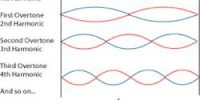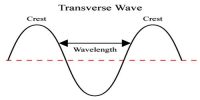Stationary wave:
When two simple harmonic waves of the same amplitude, frequency and time period travel in opposite direction in a straight line, the resultant wave obtained are called a stationary or standing wave. The formation of the stationary wave is due to the superposition of the two waves on the particles of the medium. This type of wave does not move through the medium but remains static in that region.

The amplitude of vibration of a stationary wave varies with the position. In the figure, the position of the particles 1, 3, 5 etc. which always remain at their mean positions is called nodes. i.e. the positions, where the amplitudes of the standing wave are zero, are called nodes.
The positions of the particles 2, 4, 6, etc. which vibrate simple harmonically with maximum amplitude are called antinodes.
Characteristics of stationary (or standing) waves are:
- The vibration of the particles in the stationary waves is S.H.M.
- The nodes and antinodes are produced alternately.
- The amplitude of the stationary waves is minimum at the nodes and maximum at the antinodes.
- The distance between three consecutive nodes or three antinodes or the length of two consecutive loops is the wavelength of a stationary wave.
- The change in pressure and the density of the medium is maximum at nodes and minimum at the antinodes.
- In the stationary wave, all the particles come to rest during a complete vibration.














